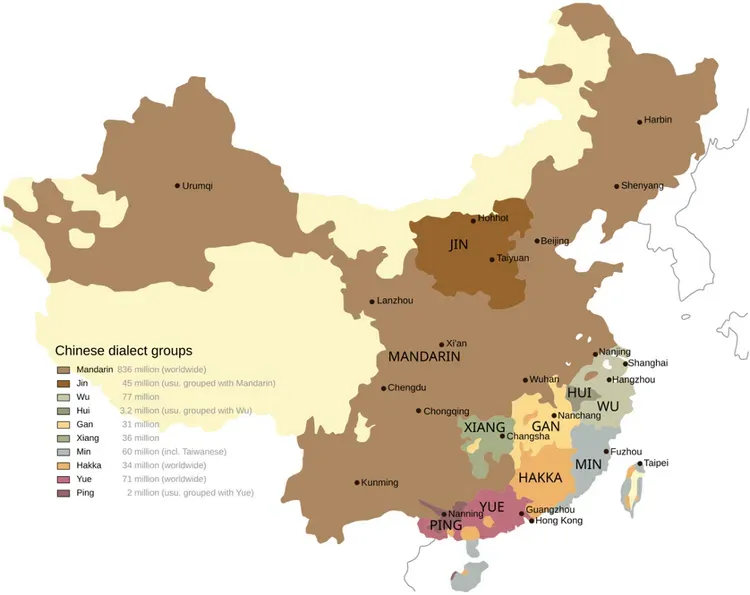China is a land of rich history, breathtaking landscapes, and a vibrant culture that has influenced the world for millennia. At the heart of this vast culture is the Chinese language—a linguistic marvel that reflects the country’s diversity, uniqueness, and complexity. In this blog post, you will discover the richness of the Chinese language, what makes it so fascinating, why mastering it can be quite challenging, and how to communicate with Chinese speakers, even if you’re not fluent in Chinese!
Ready to uncover new insights? Let’s get started!
Exploring the Rich Tapestry of Chinese Language Diversity
If you’re unfamiliar with Chinese culture, here’s a fun fact: there isn’t a single Chinese language. When we talk about the Chinese language, we’re referring to a family of languages as diverse as the regions they come from. Officially, there are ten different varieties of Chinese dialects. All these varieties are classified as Sinitic languages, a branch of the Sino-Tibetan language family.
Those recognised varieties of Chinese dialects are as follows:
1 - Standard Mandarin
Standard Mandarin, also known as 普通话 (Pǔtōnghuà) in mainland China and 国语 (Guóyǔ) in Taiwan, is the most widely spoken language in China. This is also referred to as 汉语 (Hànyǔ) because it is the language spoken by the majority Han ethnic group (汉族 Hànzú). Mandarin is China’s primary official language. It was originally based on a Chinese dialect spoken in Beijing.
2 - Min Chinese
Min Chinese (闽语, Mǐnyǔ) is predominantly spoken in Fujian province, with around 6.2% of China’s population being native Min speakers. Some popular varieties of Min Chinese include Hokkien and Teochew, which are commonly spoken by the Chinese diaspora in Southeast Asia.
3 - Wu Chinese
Wu Chinese 吴语 (Wúyǔ) is primarily used in Shanghai and the surrounding areas, including Jiangsu and Zhejiang Provinces. It’s also referred to as Shanghainese.
4 - Cantonese (Yue)
Cantonese 粤语 (Yuèyǔ) is one of the most popular Chinese dialects, along with Mandarin. Its popularity is bolstered by Hong Kong martial arts films and the Chinese diaspora. Cantonese sounds quite different from Mandarin Chinese. It is commonly spoken in the Southern Chinese provinces of Guangdong and Guangxi, Hong Kong, and Macau.
5 - Jin Chinese
Jin Chinese 晋语 (Jìnyǔ) is mainly spoken in north-central areas of China, including Shanxi Province, parts of Inner Mongolia, Hebei, Henan, and Shaanxi. There are around 48 million native Jin Chinese speakers, which is 5.1% of China’s population.
6 - Gan Chinese
Gan Chinese 赣语 (Gànyǔ) is mostly spoken in Jiangxi Province, as well as some areas of Hunan, Hubei, Fujian, and Anhui. Since it’s predominantly used in Jiangxi, Gan Chinese is sometimes referred to as 江西话 (Jiāngxīhuà). This dialect is spoken by 3.9% of China’s population and is considered to be closely related to Hakka.
7 - Hakka (Kejia) Chinese
Along with Mandarin and Cantonese, Hakka is also one of the most popular Chinese dialects abroad. Although only 3.5% of China’s population speaks Hakka, it is commonly spoken among the Chinese diaspora. The widespread of this dialect is linked to mass migration caused by war, flood, famine, and drought. Hakka speakers scattered around Guangdong, Fujian, Guangxi, Hainan, Sichuan, Jiangxi, Guizhou, Hong Kong, Taiwan, and some Southeast Asian countries like Singapore, Malaysia, and Indonesia.
8 - Xiang Chinese
Xiang Chinese 湘语 (Xiāngyǔ) is predominantly spoken in Hunan Province. For this reason, Xiang Chinese is also known as Hunanese.
9 - Huizhou Chinese
Huizhou Chinese 徽语 (Huīyǔ) is only spoken by 0.3% of the population. Native to the southern parts of Anhui province, it has a distinct sound and vocabulary.
10 - Pinghua Chinese
Pinghua Chinese 平话 (Pínghuà) speakers can be found in parts of the Guangxi Zhuang Autonomous Region. This language is closely related to Cantonese but has unique characteristics.

What Makes the Chinese Language So Unique?
The uniqueness of the Chinese language lies not only in its diversity. Some might have noticed that the Chinese language family is tonal, which uses pitch/tone to distinguish lexical or grammatical meaning. For instance, the syllable “ma” can mean “mother,” “horse,” “scold,” or “numb,” depending on the tone used. This tonal aspect makes spoken Chinese melodic but also tricky for learners!
Another unique feature of the Chinese language is that it does not have an alphabet. The writing system is “logosyllabic,” meaning each character represents a syllable of spoken Chinese. There are more than 50,000 distinct Chinese characters, and more are added every year. Apparently, you’ll need to master around 20,000 Chinese characters for daily use and 2,500 characters to read a newspaper in China.
In addition, the Chinese language is the only pictographic language still in use today. Similar to ancient Egyptian hieroglyphics, Chinese characters can convey meanings visually. For example, the character “山” (shān) resembles the shape of a mountain and actually means “mountain.” This visual nature of the language adds a layer of richness and beauty to the written form.

Why is Chinese So Difficult to Learn?
Given its unique features, it’s no surprise that many people find Chinese difficult to learn. Here are a few reasons why:
1 - Tonal Complexity
The language’s tonal nature means that mastering pronunciation requires a sharp ear and precise control over one’s voice. A slight change in tone can lead to misunderstandings, which can be both amusing and frustrating for learners.
2 - Vast Number of Characters
Learning to read and write in Chinese involves memorising thousands of characters. Each character has its own structure, and many look quite similar, which can confuse beginners.
3 - Lack of Alphabet
Without an alphabet to rely on, learners can’t simply “sound out” a word. Instead, they must memorise the pronunciation and meaning of each character individually.
4 - Cultural Nuances
Understanding the language also means grasping the cultural nuances and context in which specific phrases or expressions are used. This can be challenging for non-native speakers, as many expressions are deeply rooted in Chinese history and culture.
Despite these challenges, learning Chinese can be incredibly rewarding. It offers a deeper connection to Chinese culture and opens doors to understanding one of the world’s oldest and richest civilisations.
How to Connect with Chinese Speakers Without Knowing the Language
In today’s globalised world, communicating with Chinese speakers is increasingly important, especially for business purposes. China’s economic influence is massive, and connecting with Chinese partners, clients, or colleagues can be a significant advantage. However, its unique characteristics make learning Chinese challenging for many people. Becoming fluent in Chinese takes time, as you need to memorise various tones and thousands of characters.
The good news is that modern technology has made it easier than ever to bridge the language gap. VideoTranslatorAI is proud to offer a tool enabling you to connect with Chinese speakers in real-time, even if you don’t know how to speak Chinese at all! With our videoconferencing tool, you not only cut the distance but also break the language barrier. Whether you’re discussing business deals, collaborating on projects, or simply building relationships, our technology ensures that language barriers are no longer an obstacle.


Conclusion
The Chinese language is a living testament to the country’s vast and diverse culture. Its unique writing system, tonal nature, and the sheer number of dialects make it a fascinating yet challenging language to learn. But for those who embark on this linguistic journey, the rewards are immense—a profound understanding of a culture that has shaped the world for thousands of years.
And even if learning the language feels daunting, remember that VideoTranslatorAI is here to help! Our cutting-edge videoconferencing tool enables real-time communication between people who speak different languages. Perfect for international meetings, webinars, or virtual events, this tool is designed to make global collaboration effortless and efficient.
Curious to see how it works? Stay connected for more information!
Do not hesitate to drop your questions here or contact us at hello@videotranslator.ai!
References:
https://www.tomedes.com/translator-hub/languages-spoken-in-china https://studycli.org/learn-chinese/languages-in-china/ https://www.dailychinese.app/readings/how-chinese-is-different-from-other-languages/ https://www.thechairmansbao.com/blog/unique-chinese-language/ https://www.china-admissions.com/blog/24-amazing-facts-about-the-chinese-language/



